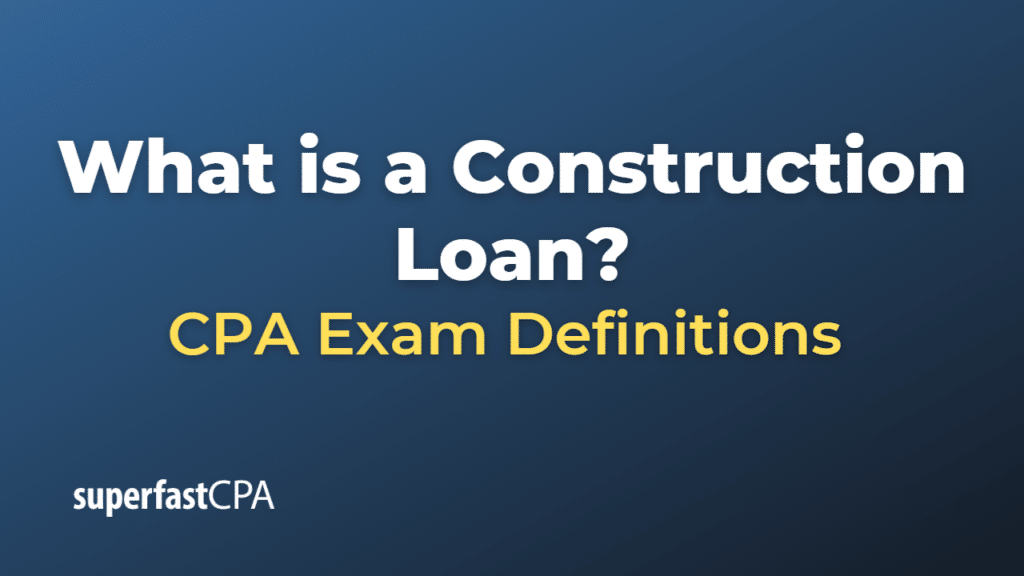Construction Loan
A construction loan is a short-term, interim financing option used to fund the costs associated with building or renovating a residential or commercial property. Construction loans are typically provided by banks, credit unions, or other financial institutions and are designed to cover expenses such as land acquisition, materials, labor, and other construction-related costs.
Construction loans differ from traditional mortgages in several ways:
- Disbursement of funds: Instead of providing the full loan amount upfront, construction loans are usually disbursed in a series of installments or “draws” as the project progresses. The borrower submits draw requests to the lender, who then releases funds based on the completion of specific milestones or stages of the construction project. This helps ensure that funds are used for their intended purpose and minimizes the risk for the lender.
- Interest-only payments: During the construction phase, borrowers typically make interest-only payments on the loan. This means they only pay the interest that accrues on the outstanding balance, rather than making principal payments. This can help reduce the financial burden on the borrower while the project is underway.
- Short-term and higher interest rates: Construction loans are usually short-term, ranging from 6 months to 2 years, depending on the project’s complexity and duration. Interest rates for construction loans are typically higher than those for traditional mortgages due to the higher risk associated with financing a construction project.
- Lender oversight: Lenders often require additional oversight during the construction process to ensure that the project stays on schedule and within budget. This may include periodic inspections, progress reports, and approval of draw requests before releasing funds.
- Conversion to a permanent loan: Once the construction project is completed, the construction loan often needs to be converted or refinanced into a permanent mortgage. This can either be done through a separate loan application or, in some cases, as part of a construction-to-permanent loan, where the construction loan automatically converts to a long-term mortgage upon completion of the project.
In summary, a construction loan is a short-term financing option designed to fund the costs associated with building or renovating a property. It offers a unique structure, with funds disbursed in stages, interest-only payments during construction, and typically higher interest rates than traditional mortgages. Once the construction project is completed, the borrower usually needs to secure a permanent mortgage to replace the construction loan.
Example of a Construction Loan
Let’s consider an example of a couple, John and Jane, who want to build their dream home on a piece of land they have purchased:
- Loan application: John and Jane approach a bank to apply for a construction loan. They submit their construction plans, budget, and timeline, as well as their personal financial information, such as income, credit score, and assets. The bank reviews their application and approves a construction loan of $400,000, based on the estimated cost of building their home.
- Disbursement of funds: The bank agrees to disburse the $400,000 loan in a series of installments or draws, as the construction progresses. For example, the first draw might cover land preparation and foundation work, the second draw for framing and roofing, the third draw for plumbing and electrical installations, and so on. John and Jane submit draw requests to the bank as they reach each milestone, and the bank releases the funds accordingly.
- Interest-only payments: During the construction phase, John and Jane make interest-only payments on the outstanding balance of the loan. This helps them manage their finances while their home is being built.
- Lender oversight: The bank conducts periodic inspections and requires progress reports from John and Jane to ensure that the construction project stays on schedule and within budget. The bank also verifies that the work completed aligns with the milestones specified in the draw requests before releasing the funds.
- Conversion to a permanent loan: Once the construction of their dream home is completed, John and Jane need to convert the construction loan into a permanent mortgage. They secure a 30-year fixed-rate mortgage for the outstanding balance of the construction loan, which allows them to make regular principal and interest payments over the long term.
In this example, the construction loan provided John and Jane with the necessary funds to build their dream home, disbursing the money in stages as the project progressed. They made interest-only payments during the construction phase, and once their home was completed, they converted the construction loan into a permanent mortgage to finance their new home over the long term.












